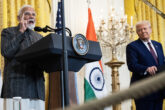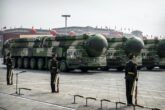July 14, 2021
The United States Can’t Afford the Brutal Price of Chinese Solar Panels
In a remote desert near the Tibetan Plateau in Northwest China, millions of solar panels produce enough electricity to power a midsize American city. This project, one of the largest solar farms ever built, uses raw materials, solar panels, and battery technologies that are produced in China. In 2019, China made 80 percent of the world’s supply of solar panels.
But buying Chinese solar panels to reduce emissions is like using gas to put out a fire. To manufacture critical raw materials like polysilicon, Chinese firms rely on coal-powered electricity in Xinjiang. Without even accounting for the energy impact of transporting the final products, a solar panel made in China has about double the carbon footprint as a similar panel manufactured in Europe.
Buying Chinese solar panels to reduce emissions is like using gas to put out a fire.
This is also about fundamental U.S. values. On June 24, the Biden administration blocked a Xinjiang-based polysilicon manufacturer due indications of forced labor. According to recent research, human rights abuses are not isolated to a single company—the issue is systemic. Every single one of the polysilicon manufacturers in Xinjiang has links to coercive Chinese Communist Party-backed “labor transfer” programs.
China’s chokehold on the solar supply chain thus presents challenges for U.S. President Joe Biden’s recent pledge to make electricity carbon-free by 2035. But supply chains are not immutable. Development and deployment of clean energy technology is not just good for the climate—it can help ensure a secure and socially responsible energy supply chain. This requires a green technology strategy for the next decade.
Read the full article from Foreign Policy.
More from CNAS
-
America’s Self-Loathing Is a Losing Hand
This article was originally published in The Washington Post.Around 10 years ago, the United States began a historic shift in its grand strategy toward China, abandoning the b...
By David Feith
-
Indo-Pacific Security / Energy, Economics & Security / Technology & National Security
Selling AI Chips Won’t Keep China Hooked on U.S. TechnologyU.S. policy should not rest on the illusion that selling chips can trap China inside the American tech ecosystem....
By Janet Egan
-
Will New Delhi-Beijing Move Beyond Friction Points? | Ex-White Official On India-China Reset
Prime Minister Narendra Modi on Friday said that India and China, as two major economies, must work together to bring stability to the global economic order. NDTV's Gaurie Dwi...
By Lisa Curtis
-
How Big Will China’s Nuclear Arsenal Get?
China’s nuclear expansion is already feeding an arms race—a contest that is accelerating partly because the finish line remains unknown....
By Jacob Stokes




